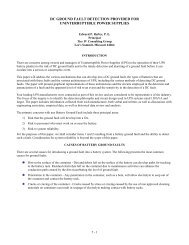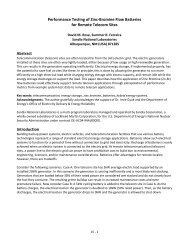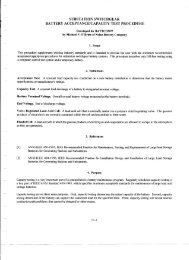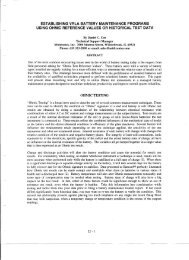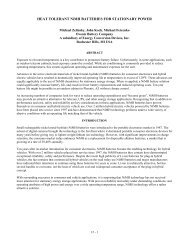Monobloc Batteries: High Temperature, Life and Catalysts - Battcon ...
Monobloc Batteries: High Temperature, Life and Catalysts - Battcon ...
Monobloc Batteries: High Temperature, Life and Catalysts - Battcon ...
Create successful ePaper yourself
Turn your PDF publications into a flip-book with our unique Google optimized e-Paper software.
At this point we have shown that high temperature can lead to increased current, increased water loss <strong>and</strong> increased corrosion<br />
of the positive grid in the battery, but what does this mean to the life of the battery. In essence, a higher temperature leads to a<br />
shorter life of the battery, but what can be expected The following table presents the effect of high temperature on battery<br />
life as predicted by applying the Arrhenius equation:<br />
Expected Actual <strong>Life</strong><br />
<strong>Temperature</strong> 5-Year 10-Year<br />
°C °F Design Design<br />
25 77 5 Years 10 Years<br />
35 95 2.5 Years 5 Years<br />
45 113 1.25 Years 2.5 Years<br />
55 131 7.5 Months 1.25 Years<br />
65 149 3.75 Months 7.5 Months<br />
As the table shows the design life is de-rated by half for each 10°C increase in temperature. As an example of how to use the<br />
table, assume that a battery user is getting 2.5 years of actual life from a battery with a design life of 5 years <strong>and</strong> that it is<br />
being run at 35°C. In this case, the battery user is getting exactly what they paid for <strong>and</strong> what the battery was designed for.<br />
The table clearly shows that high temperature can have a dramatic impact on the life of the battery. It is important to note that<br />
the highest temperatures on the table have actually been measured inside the battery compartment of an outside plant cabinet<br />
in the southern US in the summer. 13<br />
ACHIEVING DESIGN LIFE<br />
The design of batteries is a complex matter. For an excellent discussion of the similarities <strong>and</strong> differences between flooded<br />
stationary lead acid <strong>and</strong> VRLA batteries, <strong>and</strong> a bit of history on the trials <strong>and</strong> tribulations involved in the design of both types<br />
of batteries, Dr. Dave Feder’s 2001 Intelec paper is an excellent source. 16 With this background in mind, the question<br />
becomes are there steps that can be taken to ensure that the design life of a lead acid battery is achieved For any lead acid<br />
battery corrosion of the positive grid is the main <strong>and</strong> first concern. Fortunately positive grid corrosion is well understood by<br />
battery engineers <strong>and</strong> has been quantified. The most widely used graph to describe how corrosion affects the positive plate<br />
was developed by J.J. L<strong>and</strong>er. The curve that bears his name shows us that there is a zone where corrosion is minimized in a<br />
lead acid battery <strong>and</strong> also that once out of that zone corrosion of the positive grid is accelerated.<br />
As a general rule for all lead acid batteries, corrosion is a function of the charge voltage (polarization) applied to the positive<br />
plate. In all lead acid batteries there is a fixed amount of charge voltage that is supplied to the battery from the charger. This<br />
charge voltage is distributed to the negative <strong>and</strong> positive plates. The negative plate takes some of the charge voltage <strong>and</strong> the<br />
positive takes the rest. If too much oxygen/hydrogen recombination takes place on the negative plate, this plate becomes<br />
depolarized <strong>and</strong> then the positive plate will end up with all of the charge voltage. This can push the battery into the danger<br />
zone for increased positive grid corrosion (right side of the curve). This can be seen on the L<strong>and</strong>er curve in the Figure 1<br />
below:<br />
15 - 4



